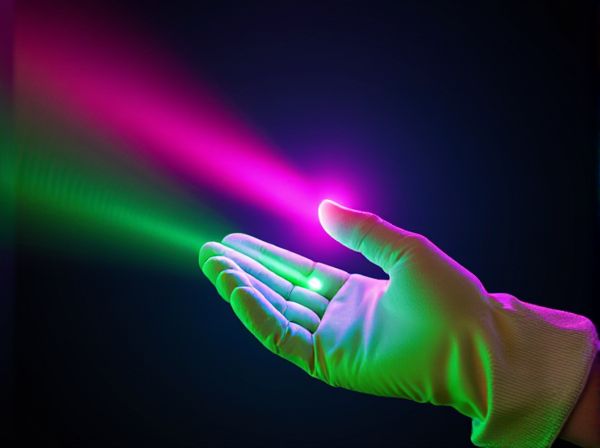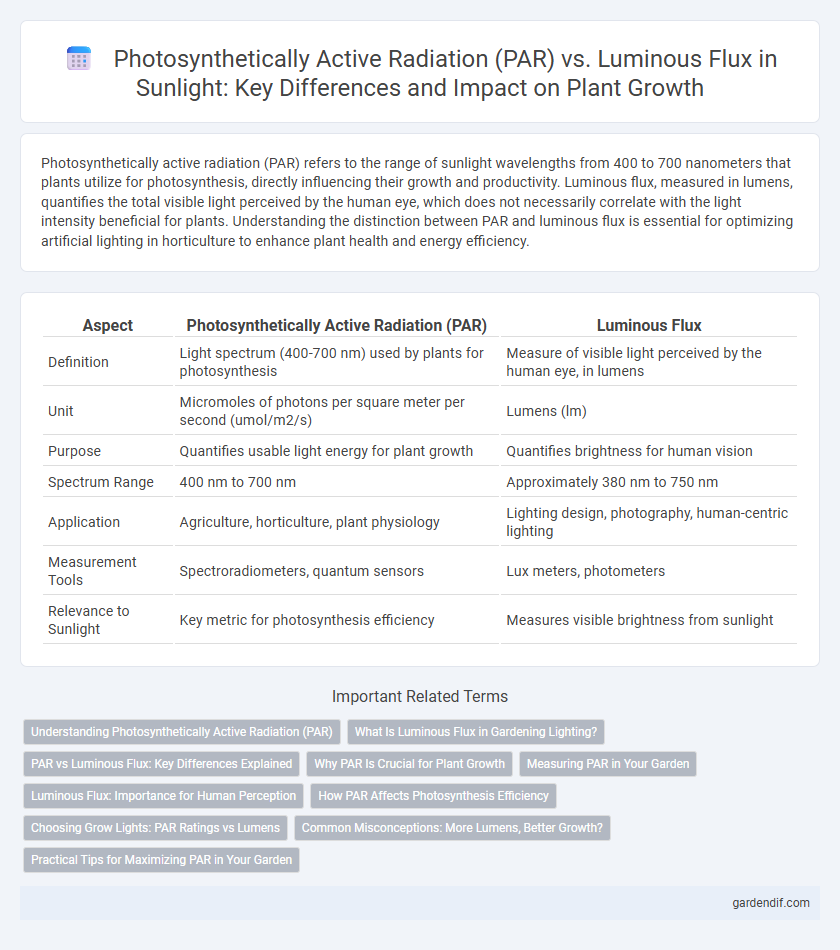
Photosynthetically active radiation (PAR) vs luminous flux Illustration
Photosynthetically active radiation (PAR) refers to the range of sunlight wavelengths from 400 to 700 nanometers that plants utilize for photosynthesis, directly influencing their growth and productivity. Luminous flux, measured in lumens, quantifies the total visible light perceived by the human eye, which does not necessarily correlate with the light intensity beneficial for plants. Understanding the distinction between PAR and luminous flux is essential for optimizing artificial lighting in horticulture to enhance plant health and energy efficiency.
Table of Comparison
| Aspect | Photosynthetically Active Radiation (PAR) | Luminous Flux |
|---|---|---|
| Definition | Light spectrum (400-700 nm) used by plants for photosynthesis | Measure of visible light perceived by the human eye, in lumens |
| Unit | Micromoles of photons per square meter per second (umol/m2/s) | Lumens (lm) |
| Purpose | Quantifies usable light energy for plant growth | Quantifies brightness for human vision |
| Spectrum Range | 400 nm to 700 nm | Approximately 380 nm to 750 nm |
| Application | Agriculture, horticulture, plant physiology | Lighting design, photography, human-centric lighting |
| Measurement Tools | Spectroradiometers, quantum sensors | Lux meters, photometers |
| Relevance to Sunlight | Key metric for photosynthesis efficiency | Measures visible brightness from sunlight |
Understanding Photosynthetically Active Radiation (PAR)
Photosynthetically Active Radiation (PAR) refers to the range of light wavelengths from 400 to 700 nanometers that plants use for photosynthesis, making it essential for plant growth and development. Unlike luminous flux, which measures visible light perceived by the human eye in lumens, PAR quantifies the photon flux density important for photosynthetic efficiency, typically expressed in micromoles of photons per square meter per second (umol/m2/s). Understanding PAR is crucial for optimizing lighting in agriculture and horticulture, ensuring plants receive adequate energy to maximize photosynthetic activity and biomass production.
What Is Luminous Flux in Gardening Lighting?
Luminous flux in gardening lighting measures the total visible light emitted by a source, expressed in lumens, which directly impacts plant growth by influencing human perception rather than photosynthesis. Photosynthetically active radiation (PAR) represents the spectrum of light (400-700 nm) plants use for photosynthesis, making it a more critical metric for evaluating light quality in horticulture. Understanding the distinction helps gardeners select lighting that maximizes photosynthetic efficiency while ensuring adequate visible illumination for monitoring plant health.
PAR vs Luminous Flux: Key Differences Explained
Photosynthetically active radiation (PAR) measures the light spectrum (400-700 nm) essential for plant photosynthesis, quantifying photons that drive energy production. Luminous flux, expressed in lumens, assesses visible light perceived by the human eye, weighted by human photopic response, unrelated to plant light absorption efficiency. PAR is critical in horticulture and agriculture for optimizing plant growth, while luminous flux guides human-centric lighting design.
Why PAR Is Crucial for Plant Growth
Photosynthetically active radiation (PAR) represents the specific spectrum of sunlight (400-700 nm) that plants utilize for photosynthesis, directly influencing their growth and development. Unlike luminous flux, which measures visible light perceived by the human eye, PAR quantifies the light energy available for chlorophyll absorption, essential for converting CO2 and water into glucose and oxygen. Optimizing PAR exposure improves plant productivity by maximizing photosynthetic efficiency, making it crucial for agricultural and horticultural practices.
Measuring PAR in Your Garden
Photosynthetically active radiation (PAR) measures the light spectrum (400-700 nm) plants use for photosynthesis, unlike luminous flux which gauges visible light perceived by the human eye. In your garden, using a PAR meter provides accurate data on the actual energy available for plant growth, ensuring optimal light conditions. Monitoring PAR helps adjust artificial lighting or plant placement to maximize photosynthetic efficiency and improve crop yield.
Luminous Flux: Importance for Human Perception
Luminous flux measures the perceived brightness of light as detected by the human eye, expressed in lumens, and is critical for evaluating lighting conditions in environments designed for human activity. Unlike Photosynthetically Active Radiation (PAR), which quantifies light in the 400-700 nm range crucial for plant photosynthesis, luminous flux encompasses the visible spectrum weighted by the human visual response curve. Understanding luminous flux is essential for optimizing indoor lighting, ensuring energy efficiency, and enhancing visual comfort in residential and commercial spaces.
How PAR Affects Photosynthesis Efficiency
Photosynthetically active radiation (PAR) represents the range of light wavelengths (400-700 nm) that plants use for photosynthesis, directly impacting the process's efficiency by optimizing energy absorption in chlorophyll pigments. Unlike luminous flux, which measures visible light intensity perceived by the human eye, PAR specifically quantifies the photon flux density relevant to photosynthetic activity, making it a critical parameter for assessing plant growth and productivity. Enhanced PAR levels improve photosynthesis efficiency by increasing the rate of light-dependent reactions, thereby boosting biomass accumulation and crop yield under optimal light conditions.
Choosing Grow Lights: PAR Ratings vs Lumens
Photosynthetically Active Radiation (PAR) measures the light spectrum plants use for photosynthesis, typically ranging from 400 to 700 nanometers, making it crucial for selecting effective grow lights. Luminous flux, measured in lumens, quantifies visible light perceived by the human eye but does not indicate the light quality plants need for growth. Choosing grow lights based on PAR ratings ensures optimal energy efficiency and plant development since these values directly reflect the usable light spectrum for photosynthesis.
Common Misconceptions: More Lumens, Better Growth?
Photosynthetically active radiation (PAR) measures the light wavelengths (400-700 nm) essential for plant photosynthesis, while luminous flux in lumens represents human-visible brightness weighted by eye sensitivity, often misleading growers. Higher lumens do not necessarily correlate with better plant growth because plants rely on specific photosynthetic light spectra rather than overall brightness perceived by humans. Understanding PAR is crucial for optimizing light sources to enhance photosynthesis and ensure effective agricultural and horticultural practices.
Practical Tips for Maximizing PAR in Your Garden
Photosynthetically active radiation (PAR) measures the light spectrum plants use for photosynthesis, whereas luminous flux quantifies visible light perceived by humans. To maximize PAR in your garden, position plants to receive direct sunlight during peak daylight hours and minimize shading from structures or taller plants. Using reflective surfaces like white walls or grow lights designed for high PAR output can significantly enhance plant growth by increasing available photosynthetic light.
Photosynthetically active radiation (PAR) vs luminous flux Infographic

 gardendif.com
gardendif.com